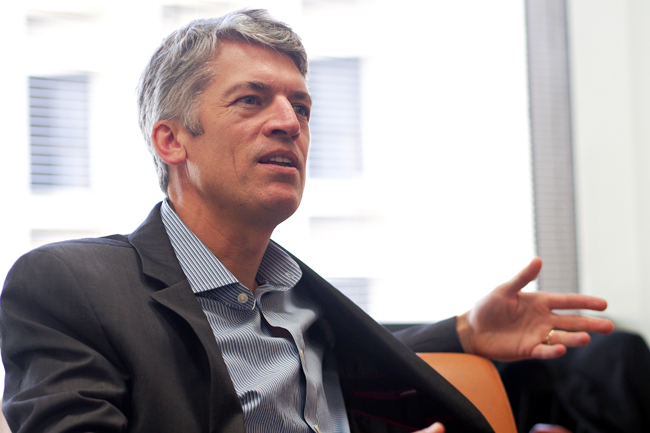Editor’s Note: This is the last in a series of Q-and-A’s with UT’s deans. Dr. Clay Johnston is dean of the Dell Medical School. He was appointed dean in January 2014. The interview has been edited for clarity. The McCombs School of Business declined our requests for an interview.
The Daily Texan: What sorts of things have happened in the medical school since the Texan last spoke to you?
Clay Johnston: We’ve been hiring a lot of people. Hiring people is one of the most important things we do. We are almost entirely focused on [hiring] leaders. Now we have three department chairs, with another four to recruit. We had a visit from the accrediting body in February. And that visit went really well. We will hear about accreditation for sure in June. If that goes well, we will start accepting applications for July 2016.
DT: What kind of relationship do you foresee between the medical school and the rest of UT?
Johnston: We have started the first program that cuts across schools, called the Design Institute for Health. It’s us and the College of Fine Arts. We will announce another program like this that will include LBJ, McCombs and the Law School within a month. In addition we will start programs that reflect how we hope to find solutions to health problems.
DT: What has the recruiting process been like so far?
Johnston: For us, the most logical way to recruit is to recruit the leaders and have the leaders recruit their people. There are some urgent needs we have to fill, so we are recruiting a small number of faculty along the way. In terms of staff, we met those needs right away. We did inherit clinical faculty from UT Southwestern.
DT: Recently, the University announced a partnership between the medical school and Huston-Tillotson University. Can you tell us about that, and what are the things you look at when it comes to working together with other organizations, such as Seton?
Johnston: We have a bunch of partnerships, and we will always rely on those. As opposed to our own stuff, we are trying to work as a coordination and creativity engine to move other entities forward. Seton is a key one because they are a primary in-patient partner. The other major partner for us is Central Health, the Travis County health care district. They make sure that poor people get health care and they do that through contracting with different providers. A lot of teaching will happen there. … Huston-Tillotson is brand new. We are focused on how we deal with mental health disparities in Travis County. Huston-Tillotson is great partner to help us think about that.
DT: How can the medical school address disparities in health care access? How could it work to alleviate some of the problems?
Johnston: I see that as one of the critical roles for us. Right now, too much money is being spent on the emergency room and stuff that happens in the hospital, whereas if we shift the dollars and spending more to promoting health, creating a better environment for people, encouraging them to make better choices and identifying conditions early, we could save tons of money and people would be happier and healthier.
That’s particularly true in neighborhoods where there’s more poverty. What we are interested in is shifting the payer model. Our role is to help these populations to identify the things that could be effective, potentially to coordinate different practitioners that are acquired to create those plans, directing payers toward wiser investment to their dollar. It will be more effective by bringing good ideas and promoting smart policies and the infrastructure.
DT: How do you plan to help with students’ tuition and also increase diversity?
Johnston: Our goal is to have no tuition for a third of our students and to keep tuition low for the other two-thirds. We have scholarships for people who plan to go into primary care — it’s probably going to be a forgivable loan program as the way to encourage it.
The diversity issue is complicated, and it’s going to be a long-term issue for us. It is important, ultimately, to have physicians look like the patients they are treating. Unfortunately, we’re nowhere close to that in the U.S. health care system. We, as a single school, cannot solve that problem, but we are trying to look at the entire pipeline to interest students in medicine as early as middle school.
DT: What role do you think the Dell Medical School will play in relation to the other medical schools in the UT System?
Johnston: We have some fabulous [medical] schools in the UT System. They have been honed through years of tradition. We have this opportunity, and responsibility, to be more representative of where the health care system is going. So the other schools are looking to us to succeed and fail because we are definitely taking some of the risks so they can learn from both.
















